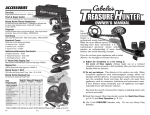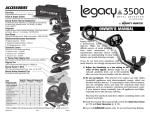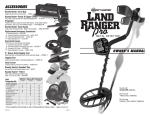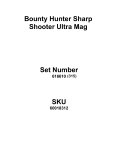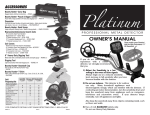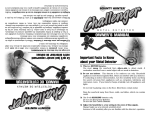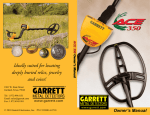Download Bounty Hunter Sharp Shooter II Owner`s manual
Transcript
ACCESSORIES Bounty Hunter Carry Bag ® Rugged double-stitched construction - CBAG-W Bounty Hunter Pouch & Digger Combo ® Pouch with 2 large pockets & 9” heavy duty digging tool. TP-KIT-W Stereo Headphones Use with Bounty Hunter metal detectors. Lightweight and adjustable with true stereo sound, adjustable volume, 1/4 jack with 1/8 adaptor, 4’ cable. HEAD-W OWNER’S MANUAL Pin Pointer Pinpoints the exact location of buried metal objects. Audio signal indicator and vibrator. Runs on (1) 9-Volt Battery. PIN POINTER-W Bounty Hunter Sand Scoop ® Large scoop with filtering holes. Made of strong plastic. SAND SCOOPBH Replacement/Accessory Searchcoils 10” Magnum Coil – 10COIL 8” Replacement Standard Coil – 8COIL-7BLK 4” Gold Nugget Coil – 4COIL The Sharp Shooter II is a professional metal detector. The concepts and terminology can be quite unfamiliar if you are new to the hobby. To understand it quickly and to get the most enjoyment possible from your detector, we strongly recommend that you: Coil Covers Protect your coil from abrasion and damage. 10” Coil Cover – 10COVER 8” Coil Cover – 8COVER-N 4” Coil Cover – 4COVER 9” Heavy-Duty Digging Tool 1) Turn the Sensitivity knob to a low setting if you get false signals. A little practice is required to understand when and how you can use the sensitivity at or near 100%. Metal blade with comfortable plastic handle and depth gauge TROWEL-2 Digging Tool Light and practical wide blade digging tool. TROWEL-W Bounty Hunter Baseball Cap ® 2) Do not use indoors. This detector is for outdoor use only. Many household appliances emit electromagnetic energy, which can interfere with the detector. If conducting an indoor demonstration, turn the sensitivity down and keep the searchcoil away from all floors, walls and metal objects. One size fits all, with Bounty Hunter® logo. BHCAP Bounty Hunter T-Shirt ® 100% cotton with Bounty Hunter® Logo. Sizes – S, M, LG, XL & XXL. BHTSHIRT 3) Do not test by placing coins on the floor. Most floors contain metal. Gold Prospecting Kits 4) Read this manual. Most importantly, review the Summary of Operating Modes. 5) Sweep the searchcoil from side-to-side. Coil motion is required in the motion modes to detect metal. 6) Use 9volt ALKALINE batteries only. Do not use Heavy Duty batteries. Do not use normal Zinc-Carbon batteries. 7) Operating Frequency: 6.5 kHz FOR COMPLETE DETAILS VISIT WWW.DETECTING.COM • 1-800-413-4131 MSS2B Rev.4 082313 TABLE OF CONTENTS TERMINOLOGY . . . . . . . . . . . . . . . . . . . . . . . . . . . . . . .3 ASSEMBLY . . . . . . . . . . . . . . . . . . . . . . . . . . . . . . . . . .4-5 BATTERIES . . . . . . . . . . . . . . . . . . . . . . . . . . . . . . . . . . .6 QUICK-START DEMO . . . . . . . . . . . . . . . . . . . . . . . . . . .7 TREASURE HUNTER’S CODE OF ETHICS: • Always check Federal, State, County and local laws before searching. • Respect private property and do not enter private property without the owner’s permission. • Take care to refill all holes and leave no damage. • Remove and dispose of any and all trash and litter found. • Appreciate and protect our inheritance of natural resources, wildlife and private property. • Act as an ambassador for the hobby, use thoughtfulness, consideration and courtesy at all times. • Never destroy historical or archaeological treasures. • All treasure hunters may be judged by the example you set; always conduct yourself with courtesy and consideration of others BASIC OPERATION . . . . . . . . . . . . . . . . . . . . . . . . .8 & 9 SUMMARY OF OPERATING MODES . . . . . . . . . . . . . .10 LCD TARGET DISPLAY . . . . . . . . . . . . . . . . . . . . . . . . .11 INDICATORS & SENSITIVITY ADJUSTMENT . . . . . . .12 USING HEADPHONES . . . . . . . . . . . . . . . . . . . . . . . . .12 AUDIO TARGET IDENTIFICATION . . . . . . . . . . . . . . .13 IN THE FIELD TECHNIQUES Motion Modes . . . . . . . . . . . . . . . . . . . . . . . . .14 & 15 No-Motion Mode . . . . . . . . . . . . . . . . . . . . . . . . . . .16 FIRST TEXAS PRODUCTS, LLC 5-YEAR LIMITED WARRANTY Register your warranty on-line for a chance to win a FREE DETECTOR. For details, visit www.detecting.com Bounty Hunter® Metal Detectors are warranted against defects in workmanship or materials under normal use for five years from date of purchase to the original user. Liability in all events is limited to the purchase price paid. Liability under this Warranty is limited to replacing or repairing, at our option, any Bounty Hunter® Detector returned, shipping cost prepaid, to First Texas Products, LLC. Damage due to neglect, accidental damage or misuse of this product is not covered by this warranty. Proof of purchase is required to make a claim under this warranty. NOTE TO CUSTOMERS OUTSIDE THE U.S.A. This warranty may vary in other countries, check with your distributor for details. Warranty does not cover shipping costs METAL DETECTING APPLICATIONS . . . . . . . . . . . . . .17 According to FCC part 15.21 Changes or Modifications made to this device not expressly approved by the party responsible for compliance could void the users authority to operate this equipment. TROUBLESHOOTING GUIDE . . . . . . . . . . . . . . . . . . . .18 This device complies with FCC Part 15 Subpart B Section 15.109 Class B WARRANTY . . . . . . . . . . . . . . . . . . . . . . . . . . . . . . . . . .19 All rights reserved, including the right to reproduce this book, or parts thereof, in any form, except for the inclusion of brief quotations in a review. Copyright ©2012 by First Texas Products, L.L.C. ACCESSORIES . . . . . . . . . . . . . . . . . . . . . . . . .Back Cover Published by First Texas Products, L.L.C. Bounty Hunter® and Pioneer® are registered trademarks of First Texas Products, L.L.C. www.detecting.com First Texas Products, LLC 1465-H Henry Brennan El Paso, TX 79936 PH: (915) 633-8354 Fax: (915) 633-8175 2 MADE IN USA MSS2B - 093010 19 TROUBLESHOOTING TERMINOLOGY TROUBLESHOOTING GUIDE SYMPTOM CAUSE Detector chatters • Using detector or beeps erratically indoors • Using detector near power lines • Using 2 detectors in close proximity • Highly oxidized buried object • Environmental electromagnetic interference SOLUTION • Use detector outdoors only • Move away from power lines • Keep 2 detectors at least 30’ apart • Only dig up repeatable signals • Reduce sensitivity until erratic signals cease Constant low tone • Discharged batteries • Replace batteries or constant repeating • Wrong type of • Use only 9V tones batteries alkaline batteries LCD does not lock • Multiple targets on to one Target-ID present or detector emits • Highly oxidized multiple tones target • Sensitivity set too high No power, no sounds 18 • Dead batteries • Move coil slowly at different angles • Reduce sensitivity • Replace batteries The following terms are used throughout the manual, and are standard terminology among detectorists. ELIMINATION Reference to a metal being "eliminated" means that the detector will not emit a tone, nor light up an LCD indicator, when a specified object passes through the coil’s detection field. DISCRIMINATION When the detector emits different tones for different types of metals, and when the detector "eliminates" certain metals, we refer to this as the detector "discriminating" among different types of metals. Discrimination is a fixed-start-point elimination system. NOTCH Notching is the elimination of an item, or range of items, within the metallic spectrum. We "notch-out" an object selectively. Objects to the left and right on the metallic spectrum are retained. Notching creates a variable rejection window. RELIC A relic is an object of interest by reason of its age or its association with the past. Many relics are made of iron, but can also be made of bronze or precious metals. IRON Iron is a common, low-grade metal that is often an undesirable target in certain metal detecting applications. Examples of undesirable iron objects are old cans, pipes, bolts, and nails. Sometimes, the desired target is made of iron. Property markers, for instance, can contain iron. Valuable relics can also be composed of iron; cannon balls, old armaments, and parts of old structures and vehicles can also be composed of iron. FERROUS Metals which are made of, or contain, iron. PINPOINTING Pinpointing is the process of finding the exact location of a buried object. Long-buried metals can appear exactly like the surrounding earth, and can therefore be very hard to isolate. PULL-TABS Discarded pull-tabs from beverage containers are the most bothersome trash items for treasure hunters. They come in many different shapes and sizes. We have incorporated special features into the detector to let you automatically eliminate the most common types, using the AutoNotch Mode. Since there are many different types, some must be "Notched-Out" manually. GROUND BALANCE Ground Balancing is the ability of the detector to ignore, or "see through," the earth’s naturally occurring minerals, and only sound a tone when a metal object is detected. WATERPROOF The searchcoil can be submerged in water. The control housing and cable-to-housing connection must, however, stay dry. • Cord not connected • Check connections securely COINSHOOTING • Not moving Searchcoil CACHE HUNTING • Sweep searchcoil from side-to-side Finding buried coins is the most popular metal detecting application. The most valuable are very old; take care in unearthing them to avoid damage. Pronounced “cash”. A cache is a buried or hidden valuable stored inside a case, strong box, or bag. 3 METAL DETECTING APPLICATIONS ASSEMBLY Nut Adjusting the Armrest The most popular metal detecting application is coinshooting. When coinshooting, you want to discriminate out pull tabs, screw caps, and iron objects. Beware that highly oxidized steel may also be detected. The armrest may be moved forward or backwards by removing the single screw and nut, and then repositioning the 2-piece armrest. Users with shorter arms may find the armrest more comfortable in the forward position. In order to move the armrest backwards, the plastic plug must be removed from the aluminum tube. Armrest Strap (not included) Some users prefer to use a strap when swinging the detector vigorously, in order to hold the detector secure against the arm. The strap may be purchased as an optional accessory. COINSHOOTING: Armrest Control settings required. 1.) Press DISC touch pad. 2.) Turn the Discrimination Knob to the 3:00 position. RELIC HUNTING: Screw Hand-grip S-Rod Locking Collar A relic is a historical object, sometimes of great value. Relics can be found in abandoned homes, plowed fields or even your own backyard. Research the local library to learn of historical events or places in the area. You can then target your search to a specific area and gain valuable insight into your local history. Control settings required. 1.) Press ALL METAL touchpad. 2.) Turn the DISCRIMINATION knob 100% counterclockwise. Many relics are iron, so you do not want to discriminate. Or use No-Motion All Metal Mode. CACHE HUNTING: Cable Plug Searchcoil Cable A cache, pronounced “cash” is a buried or hidden valuable stored inside a case, strong box, or bag. A cache can be hidden in the floor or walls of a house, or buried nearby. Operate in the ALL METAL Mode. Control settings required. 1.) Press ALL METAL touchpad. 2.) Turn the DISCRIMINATION knob 100% counterclockwise. Or use No-Motion All Metal Mode. JEWELRY HUNTING: The detector can also be used without the strap with no compromise to detector balance and stability under most conditions. Knurled Knob OTHER APPLICATIONS: Searchcoil 4 Jewelry can be found wherever people congregate. Beaches, parks, school yards and fair grounds are all littered with lost jewelry. Your greatest challenge is the interference from pull tabs and cans. You must use a discrimination mode: AUTO NOTCH is best. Control settings required. 1.) Press the AUTO NOTCH touchpad. 2.) Set Discrimination knob at 2:00. Dig only the repeatable low and high tones, avoid the broken or non-repeatable tones. Use your Sharp Shooter II to find property markers, machine parts, and lost keys. Keep your detector in ALL METAL Mode for these tasks. Gold prospecting also requires an ALL METAL Mode. 17 IN THE FIELD TECHNIQUES - No-motion mode In the No-Motion All Metal Mode, coil sweep technique is not important. Rather, user retuning is critical. The detector does not automatically adjust to changing ground and environmental conditions; the operator is required to make the adjustment. If the detector sounds a constant tone over all areas of the ground, retune the detector by pressing the Retune button. This action will “Ground Balance” the detector. RETUNING Keep the coil still, just above the ground surface, and press the Retune button. Make sure that the spot on the ground you chose for tuning did not contain metal; pass over the area with the coil again to insure that the detector does not emit a tone. TEMPERATURE CHANGE If the detector moves from one temperature environment to another, or if the temperature changes, you must retune the detector until the temperature stabilizes. If you move from a cooler to a warmer environment, the detector may emit a constant tone; if so, retune. If you move from a warmer to cooler environment, the detector may lose sensitivity; if so, retune. PINPOINTING How To Pinpoint Targets Using The ALL METAL Mode When you’ve discovered a target you wish to dig, do the following: 1. Hold the searchcoil about half an inch above the ground, off to the side of where you think the target probably is. 2. Tap the ALL METAL touchpad button. NOTE: unlike the other modes, this mode does not require the searchcoil to be in motion to detect a target. 3. Lift the searchcoil slightly, and pass it over the target. The sound will be loudest over the center of the target. To Narrow It Down Further: 4. Now that you know about where the target is, again lower the searchcoil to about half an inch above the ground, near the center of the target but not right over the top. Tap the Retune button. The sound will instantly go away. 5. Lift the searchcoil slightly and move it horizontally over the target. The audible response zone will be much narrower. If you move the searchcoil around right and left and also forward and back, making an “X” pattern over the target, you can determine the location of the target usually within an inch or two. NOTE: if at any time it seems like the signal may be drifting, just tap the Retune button when away from metal objects. This restores the signal to its zero level. Detection Field The No-Motion Mode’s detection field depends on the size of the target. Large Objects After detecting a target, lift the coil off the ground to a distance where you hear the faintest tone. Move the coil over the ground at this height. If the tone does not fade, you have detected a large or irregularly shaped object. Outline the object with slow coil movements. If you can outline an area larger than the size of the inside coil, you then have a large target, or several targets. Large objects can be detected when they enter the range of the outside coil. 16 ASSEMBLY Assembling your Sharp Shooter II Metal Detector is easy and requires no tools. Just follow these steps: 1 Using ● the supplied bolt and knurled knob, attach the searchcoil to the lower stem. 2 Press the button on the upper end ● of the lower stem and slide the lower stem into the upper stem. Adjust the stem to a length that lets you maintain a comfortable upright posture, with your arm relaxed at your side. Maintain the searchcoil about 1 inch above the ground as you sweep. 3 Wind ● the searchcoil cable around the stem. Leave enough slack in the cable to let you adjust the coil when you are hunting on uneven ground. Then tighten the knob at the end of the searchcoil. Note: To adjust the coil, simply loosen the knob. 4 Insert ● the coil’s plug into the matching connector on the control housing. Be sure the holes and pins line up correctly. Caution: • Do not force the plug in. Excess force will cause damage. • To disconnect the cable, pull out the plug. Do not pull on the cable. 5 IN THE FIELD TECHNIQUES - motion modes BATTERIES IMPORTANT: Always use ALKALINE batteries for optimal performance. Always remove the batteries for prolonged storage. DO NOT MIX OLD AND NEW BATTERIES CHECK THE BATTERIES if your detector exhibits any of the following symptoms: 1 ● 2 ● 3 ● The unit does not turn on. Low speaker volume. Unable to tune detector with the discriminate knob. The Low Battery indicator light will come on and stay on whenever the batteries need replacing. It should flash momentarily when the Power Switch is turned on. IMPORTANT: Your Sharp Shooter II metal detector requires two 9-Volt ALKALINE batteries. Follow these steps to install the batteries. 1 Carefully remove the battery com● partment door by pressing the release clip on the right side of the door. 2 ● Snap one battery onto each of the terminals and place the batteries inside the compartment. 3 Replace the compartment door by ● carefully inserting opposite side of clip first. Then press down on clip side until battery door snaps into place. Release Clip Both Batteries terminals facing in This device has been designed to operate with the searchcoils listed below, and having a maximum gain of 3 dB. Searchcoils not included in this list or having a gain greater than 3 dB are strictly prohibited for use with this device. The required searchcoil impedance is 102 ohms. Swing the searchcoil slowly, overlapping each sweep as you move forward. It is important to sweep the coil at a consistent speed over the ground as you search. After identifying a target, your sweep technique can help in identifying both the location and the nature of the target. If you encounter a weak signal, try moving the coil in short, rapid sweeps over the target zone; such a short rapid sweep may provide a more consistent target identification. Most worthwhile objects will respond with a repeatable tone. If the signal does not repeat after sweeping the coil directly over the suspected target a few times, it is more than likely trash metal. Crossing the target zone with multiple intersecting sweeps at multiple angles is another way to verify the repeatability of the signal, and the potential of the buried target. To use this method, walk around the target area in a circle, sweeping the coil across the target repeatedly, every 30 to 40 degrees of the circle, about ten different angles as you walk completely around the target. If a high-tone target completely disappears from detection at a given angle, chances are that you are detecting oxidized ferrous metals, 10COIL, 4COIL, 8COIL, 8COIL-7, 8COIL-7BLK, 8COIL-CAMO, 8COIL-UM The following statement is not relevant to metal detectors but is printed here to satisfy legal notification requirement: “To reduce potential radio interference to other users, the searchcoil type and its gain should be so chosen that the equivalent isotropically radiated power (e.i.r.p.) is not more than that permitted for successful communication.” 6 15 WHAT READS LIKE THIS …MAY ACTUALLY BE THIS rather than a silver or copper object. If the tone changes at different angles, you may have encountered multiple objects. If you are new to the hobby, you may want to dig all targets at first. With practice in the field, you will learn to better discern the nature of buried objects by the nature of the detector’s response. You may encounter some false signals as you proceed. False signals occur when the detector beeps, but no metal target is present. False signals can be induced by electromagnetic interference, oxidation, or highly mineralized ground soils. If the detector beeps once, but does not repeat the signal with several additional sweeps over the same spot, there is probably no target present. When searching very trashy ground, it is best to scan small areas with slow, short sweeps. You will be surprised just how much trash metal and foil you will find in some areas. The trashiest areas have been frequented by the most people, and frequently hold the most promise for finding the most lost valuables. Also maintain the searchcoil positioned just above the surface of the ground, without making contact with the ground. Making contact with the ground can cause false signals. IN THE FIELD TECHNIQUES - Motion modes PINPOINTING COIL MOVEMENT Accurate pinpointing takes practice and is best accomplished by “X-ing” the target area. When swinging the coil, be careful to keep it level with the ground about one inch from the surface. Never swing the coil like a pendulum. 1. Once a buried target is indicated by a good tone response, continue sweeping the coil over the target in a narrowing side-to-side pattern. 2. Take visual note of the place on the ground where the “beep” sounds. 3. Stop the coil directly over this spot on the ground. 4. Now move the coil straight forward and straight back towards you a couple of times. 5. Again make visual note of the spot on the ground at which the “beep” sounds. 6. If needed, “X” the target at different angles to “zero in” on the exact spot on the ground at which the “beep” sounds. When pinpointing a target, try drawing an “X”, as illustrated, over where the tone is induced. The coil should be swung in a halfcircle movement as illustrated here. Repeat this motion every step you take to guarantee that the area is covered thoroughly. 14 WRONG CORRECT QUICK-START DEMO I. SUPPLIES NEEDED • • • • A Nail A small piece of aluminum foil A large screwdriver or other large iron object A zinc penny (dated after 1982) • Nickel • Dime • Quarter II. POSITION THE DETECTOR a. Place the detector on a table, with the searchcoil hanging over the edge. (or better, have a friend hold the detector, with the coil off the ground) b. Keep the searchcoil away from walls, floors, and metal objects. c. Remove watches, rings and other jewelry or metal objects from hands and wrists. d. Turn off appliances or lights that cause electromagnetic interference. e. Pivot searchcoil to a position parallel to the ground. III. POWER UP a. Turn the detector on and turn the sensitivity knob to the 3:00 position. b. Press the Retune touchpad. IV. HOLD OBJECTS OVER SEARCHCOIL TARGET DEPTH ESTIMATION After verifying a desirable target, pass the coil again, but raise the coil 1” over the ground, progressively higher with each sweep. Note the coil elevation at which the signal disappears. With practice, you will be able to approximate target depth. a. Notice the single tone, regardless of the object. b. Motion is not required. The detector will emit sound whenever a metal object is over the searchcoil. V. ENTER DISCRIMINATION MODE a. Press the DISC touchpad. b. Move the Discrimination Knob 100% counterclockwise. VI. WAVE OBJECTS OVER SEARCHCOIL a. Wave coins with flat surface parallel to coil. This is how you’ll find them buried in the ground. b. Notice the different tones. c. Watch the LCD indicator for target identification. VII. DISCRIMINATE a. Waive the nail and slowly turn the Discrimination Knob clockwise until the nail is eliminated. b. Continue eliminating objects one-by-one, by turning the Discrimination Knob clockwise as you wave each object. Stop turning after the zinc penny is eliminated. c. The objects will be eliminated in approximately this order: 1) Nail 2) Screwdriver 3) Foil 4) Nickel 5) Zinc Penny VIII. NOTCH a. Press the Notch touchpad. b. Position the Discrimination Knob so that the penny is eliminated. c. Notice that the nickel is now detected. The penny has been "notched-out." 7 BASIC OPERATION TURN THE DETECTOR ON Go outdoors to your desired treasure-hunting location. Click the left knob to the on position. Three tones will sound. The detector automatically enters the DISCRMINATION Mode. AUDIO TARGET-ID -Motion modes only In the DISC, NOTCH or AUTONOTCH Modes, the detector emits three distinct tones, which classify metal objects into categories IRON & STEEL: NO-MOTION ALL METAL MODE To operate in this mode: • Hold the searchcoil over the ground surface, about 1/2 inch. • Press the ALL METAL touchpad and then the RETUNE Touchpad. The detector will emit only one monotone sound, regardless of the type of metal detected. If the detector emits a constant tone, retune the detector, by pressing RETUNE, with the searchcoil just above the ground surface. Make sure that the ground area chosen for tuning the detector does not contain metal; if unsure, switch into DISC Mode and verify that the detector does not emit tones as you sweep the coil over the chosen spot. Ground conditions can change over short distances. Until you become familiar with the detector’s volume level, retune the detector periodically by pressing the Retune button. Temperature changes also require retuning in the motion ALL METAL Mode. If the detector emits a constant tone, or loses sensitivity, retune. If you have stored the detector indoors and move outdoors immediately to a different temperature environment and begin detecting, retune the detector periodically until the coil temperature stabilizes. This retuning is only necessary in the ALL METAL Mode. In the DISCRIMINATION Mode most iron and steel objects will induce a low tone. Highly oxidized iron can induce a high tone, depending on the Discrimination control setting. For instance, some rusted bottle caps will induce a high tone and indicate to the right of the LCD target display. GOLD: Gold objects will induce a low or medium tone, depending on their sizes. Very small gold objects will indicate on the left-most segment. Large gold objects will read under the Zinc segment. If you are gold prospecting, you will usually be looking for natural gold in an area which it does not contain much trash, and can therefore ignore the specific segment descriptions. DISCRIMINATION Mode To operate in this mode: • Press the DISC touchpad. • Reduce the Sensitivity Control to the 2:00 or 3:00 position. • Sweep the coil over the surface of the ground using a slow, level, overlapping motion. PULL TABS: Pull tabs are the most bothersome trash items for detectorist. Most will induce a medium tone. Most will be eliminated automatically in the AUTO NOTCH Mode, or alternatively be manually “notched out” in NOTCH Mode with the Discrimination control. The older pull tabs (those not attached to the can after opening) are sometimes broken in half; these broken tabs can induce low tones. Highly oxidized pull tabs can also induce high tones. It can be very difficult to differentiate pull tabs from gold rings. When they both induce medium tones, you might notice a “double beep” from a gold ring but a “single beep” from pull tabs. To achieve this distinction, sweep the searchcoil very slowly, and at different angles. Two tones might signal as the detector passes over each side of the round ring. COPPER, SILVER & BRASS: Most valuable coins are composed of these metals and will usually induce a high tone. Valuable objects other than coinage can also be composed of copper, silver and brass. LOW TONE MEDIUM TONE HIGH TONE Nails & Bottle Caps, Gold & Nickel Old & New Pull Tabs, Zinc, Pennies (Post 1982), Larger Gold Objects Copper, Silver & Brass Copper Pennies (Pre 1982) Note: all ferrous metals are eliminated from detection. Audio Target Identification (ATI) classifies metals into three categories. 8 1 INDICATORS & SENSITIVITY ADJUSTMENT BATTERY INDICATOR: The LOW BATT indicator will flash as the unit is powered on. If the indicator comes on and stays on, replace the batteries. MODE INDICATOR: Choose from one of the four operating modes by pressing the touch pad. An arrow will indicate the current operating mode. Change to any mode at any time by pressing the corresponding touchpad Note: The Retune touchpad is used only to ground balance the detector when operating in the ALL METAL Mode. EMI are power lines, both suspended and buried, and broadcasting antennas. Machinery, when in operation, can also produce EMI. EMI comes from most household appliances, so YOUR DETECTOR CAN BEHAVE VERY ERRATICALLY INDOORS. If you want to test it indoors, turn off the TV and microwave. If you have lights with dimmer switches, also turn these off; dimmer switches can produce lots of EMI. If your detector chatters with the SENSITIVITY knob in the 100% clockwise position, reduce the sensitivity until the chatter stops (usually to the 1:00 or 3:00 position). If you suspect the presence of deeper targets underneath a shallower target, reduce the SENSITIVITY to eliminate the detection of the deeper target to properly locate and identify the shallower target.: SENSITIVITY ADJUSTMENT: The principle use for the SENSITIVITY knob is to eliminate ELECTROMAGNETIC INTERFERENCE (EMI). EMI is both naturally-occurring and man-made. Common sources of USING HEADPHONES Using headphones (not supplied) improves battery life, and prevents the sounds from annoying bystanders. It also allows you to hear subtle changes in the sound more clearly, particularly if searching in a noisy location. For safety reasons, do not use headphones near traffic or where other dangers are present. This device is to be used with interconnecting cables/headphone cables shorter than three meters 12 BASIC OPERATION DISCRIMINATION Mode - continued APPROXIMATE • Turn the right knob, DISCRIMINATION, DISCRIMINATION to eliminate additional unwanted POSITIONS items from detection as illustrated to the right. These positions are approximate; objects are found in many shapes and sizes. The detector will emit one of three tones, depending on the type of metal detected. The top display will indicate the type of metal targeted. A valuable target is indicated by a consistent tone and a repeatable target indication as you sweep back and forth over the same spot on the ground. Non-repeating tones usually indicate the presence of trash objects or highly oxidized metals. You can increase the level of sensitivity, depending on the ground conditions. If the detector emits false signals, simply reduce the Sensitivity until the false signals cease. The detector will work well with the Sensitivity in the 2:00 or 3:00 position, but higher Sensitivity settings will increase depth detection. If you need maximum depth detection, operate in the ALL METAL Mode, which allows for higher Sensitivity control settings. Note that gold is unfortunately discriminated out with common trash items. Gold’s metallic signature covers a broad portion of the metallic spectrum. If searching for gold jewelry in trashy areas, use AUTO NOTCH and be prepared to dig up some trash items in your search for gold. NOTCH Mode To operate in this mode: • Press the NOTCH touchpad. • Use the Discrimination Knob to eliminate medium tone trash items from detection, but still retain low and high tone valuables. AUTONOTCH Mode To operate in this mode: • Press the AUTO NOTCH touchpad. • Most pull-tabs and medium tone trash items are automatically eliminated. • The Discrimination Knob operates as in the NOTCH Mode. To change into any mode at any time, simply press the desired button. The Retune button only functions when in the ALL METAL Mode. 9 SUMMARY OF OPERATING MODES LCD TARGET DISPLAY - motion modes only I. NO-MOTION ALL METAL MODE • Deepest Seeking Mode • No motion is required • All metals will be detected • One tone only • Manual Ground Balance: User must tune and retune with the Retune button. To Operate: 1) Press All Metal button. 2) Press Retune button, and re-tune with Retune as necessary. Applications: Pinpointing Objects located in motion modes Relic Hunting Cache Hunting Household applications: finding lost items, locating property markers II. MOTION ALL METAL MODE • Motion Required • All metals will be detected • Three-tone Audio Target Identification To Operate: 1) Press DISC button. 2) Keep Discrimination Knob 100% counterclockwise. 3) Reduce Sensitivity Knob in event of false signaling. Applications: Relic Hunting Cache Hunting Household applications: finding lost items, locating property markers III. DISCRIMINATION MODE • Motion Required • Three-tone audio target identification • Discrimination Knob allows user to eliminate unwanted items. • Discrimination is a fixed-start-point system. Items are cumulatively eliminated. • As you turn the Discrimination knob farther clockwise, more objects are eliminated, including the first items eliminated. • Reduce Sensitivity if the detector emits false or non-repeatable signals. • Automatic Ground Balance: detector automatically adjusts to ground mineralization as you sweep the coil. To Operate: 1) Press DISC button 2) Move Discrimination Knob to desired setting. 3) Reduce Sensitivity Knob in event of false signaling. Applications: Coin-Shooting Jewelry Hunting IV. NOTCH MODE • Automatically eliminates all ferrous objects. • Discrimination Knob allows user to eliminate medium-tone trash items, but retain low and high-tone valuables. To Operate: 1) Press NOTCH button. 2) Move DISCRIMINATION knob to desired setting Other Operations and Applications: same as Discrimination Mode. V. AUTONOTCH MODE • Automatically eliminates all ferrous objects. • Automatically eliminates most pull-tabs. • Discrimination Knob allows user to eliminate medium-tone trash items, but retain low and high-tone valuables. To Operate: 1) Press AUTO NOTCH button Other Operations and Applications: same as Discrimination Mode. 10 11 Please refer to the display on your detector and reference the TARGET-ID categories below applicable to your model (not all detectors include all of these categories). READING THE DISPLAY The Liquid Crystal Display (LCD) shows the PROBABLE identification of the targeted metal. The detector will register a consistent target identification, upon each sweep of the coil, when a buried target has been located and identified. If, upon repeated passes over the same spot, the target identification reads inconsistently, the target is probably a trash item, or oxidized metal. With practice, you will learn to unearth only the repeatable signals. The segment identifications are highly accurate, when detecting the objects described on the label. However, if an object registers in a given category for an unknown buried object, you could be detecting a metallic object other than the object described on the label, but with the same metallic signature. Also, the greater the distance between the target and the coil, the less accurate the target identification. GOLD TARGETS Gold objects will register toward the middle or left-of-center on the LCD scale. Gold flakes may register under iron. Small gold items may register under foil or 5¢. Large gold items will register toward the center of the scale. SILVER TARGETS: Silver objects will register to the right of the scale, under dime or higher. IRON: All sizes of iron objects will register on the far-left side of the scale. This could indicate a worthless item such as a nail, or a more valuable historic iron relic. FOIL: Aluminum foil, such as a gum wrapper, will register as foil. A small broken piece of pull tab may also register here. 5¢: Most newer pull-tabs from beverage cans, the type intended to stay attached to the can, will register here. Many gold rings will also register here. ALUM: Older pull tabs, which always detached completely from the can, register here. Many medium size gold ring also register here. PT (pull-tabs): Pull-tabs from older beverage cans will register here. Few newer pull-tabs will also register here. Many gold rings will also register here. S-CAP: Older screw caps from glass bottles will register here. Large gold rings, like a class ring, could also register here. Some non-U.S. coins of recent vintage will also register here. Zinc: Medium conductivity objects and many non-U.S. coins of recent vintage are classified here. The Target Identification Categories to the right of the display, such as copper coins, 10¢, DIME, 25¢, Quarter, 50¢, $1 accurately identify these U.S. coins. When used in areas outside the U.S., these categories identify coins or metal objects of high relative conductivity (such as silver coins or relics), or large objects made of any type of metal. Caution: The target indications are visual references. Many other types of metal can fall under any one of these categories. While the detector will eliminate or indicate the presence of most common trash items, it is impossible to accurately classify ALL buried objects.












